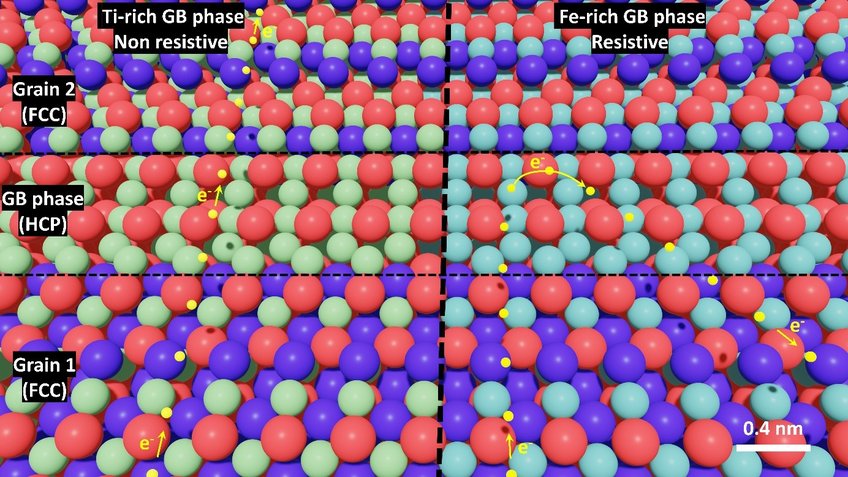An addition of titanium makes a thermoelectric material more efficient
When fossil fuels, but also biofuels, are burned, large amounts of the energy are lost as waste heat. Thermoelectric materials could convert this heat into electricity, but they are not yet efficient enough for technical application. A team from the Max Planck Institut für Eisenforschung has now increased the efficiency of a thermoelectric material by elucidating the influence of the microstructure on the material and optimizing the material’s properties by adding titanium.

The chemistry and atomic arrangement of the grain boundary phases define the electron transport through the grain boundaries. The titanium-rich grain boundary phase provides a conductive path (left) while the iron-rich grain boundary phase is resistive to electrons (right).
© R. Bueno Villoro, Max-Planck-Institut für Eisenforschung GmbH
The climate crisis is forcing us not only to phase out fossil fuels, but also to save energy. Especially where fossil fuels cannot yet be replaced so quickly, they should at least be used efficiently – for example, by generating electricity from the waste heat of energy-intensive industrial plants or power stations. At present, around 17 percent of the energy used in European industry is lost as waste heat. It could be harnessed with the help of thermoelectric materials. In such thermoelectrics, an electrical voltage is generated when they are exposed to a temperature difference. However, current thermoelectrics are not efficient enough to be used on a large industrial scale. A research team led by the Düsseldorf-based Max Planck Institut für Eisenforschung has now succeeded in optimizing a thermoelectric, as the materials are known in technical jargon, and thus come closer to industrial use. The team published its findings in the journal Advanced Energy Materials.
The team studied an alloy of niobium, iron and antimony that converts waste heat into electricity at temperatures ranging from about 70 to more than 700 degrees Celsius with an efficiency of eight percent – making the alloy currently one of the most efficient thermoelectrics. Only a material made of bismuth and tellurium achieves similar values. However, bismuth telluride is only suitable for use at relatively low temperatures and is mechanically less stable than the thermoelectric made of niobium, iron and antimony. In addition, its constituents are less readily available.
Titanium improves electrical conductivity
To further increase the efficiency of the thermoelectric made of niobium, iron and antimony, the researchers focused on its microstructure. Like most metals, thermoelectric materials are composed of tiny crystals. The composition and structure of the grains, as well as the properties of the spaces between them, known as grain boundaries, are crucial to the thermal and electrical conductivity of thermoelectric materials. Previous research has shown that grain boundaries reduce both the thermal and electrical conductivity of the material. For the highest possible efficiency, the thermal conductivity should be as low as possible so that the heat, i.e. the energy, remains in the material. The electrical conductivity, however, should be high in order to convert as much heat as possible into electricity. The goal of the team from the Max Planck Institut für Eisenforschung, the Northwestern University (USA) and the Leibniz Institute for Solid State and Materials Research Dresden was therefore to optimize the grain boundaries in such a way that only the thermal conductivity is reduced, but not the electrical conductivity.
“We used scanning transmission electron microscopes and atom probes to study the microstructure of the alloy down to the atomic level,” says Ruben Bueno Villoro, a doctoral student at the Max Planck Institut für Eisenforschung. “Our analysis has shown that grain boundaries need to be optimized to improve electrical and thermal properties.” The smaller the grains in the material, the higher the number of grain boundaries and the worse the electrical conductivity,” explains Siyuan Zhang, project leader in the same research group. “It doesn’t make sense to increase the size of the grains in the material, because larger grains would increase thermal conductivity and we would lose heat and therefore energy. Therefore, we had to find a way to increase the electrical conductivity despite the small grains.” The researchers solved the problem by enriching the material with titanium, which, among other things, accumulates at the grain boundaries and increases electrical conductivity. In this way, they increased the thermoelectric efficiency of the alloy by up to 40 percent. For practical applications, however, the efficiency still needs to increase significantly.
Next step: selective enrichment of titanium at grain boundaries
Now the research team is analyzing ways to selectively add titanium only to grain boundaries without enriching the entire material with titanium. This strategy saves costs and largely preserves the original chemical composition of the thermoelectric material. The current research shows how functional properties can be linked to the atomic structure of a material to specifically optimize certain properties.
Yasmin Ahmed Salem/PH






